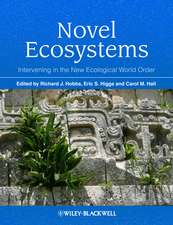The Community Ecology of Sea Otters: Ecological Studies, cartea 65
Editat de Glenn R. Van Blaricom, James A. Estesen Limba Engleză Paperback – 6 dec 2011
Din seria Ecological Studies
- 18%
 Preț: 1118.93 lei
Preț: 1118.93 lei -
 Preț: 553.72 lei
Preț: 553.72 lei - 18%
 Preț: 1680.55 lei
Preț: 1680.55 lei - 18%
 Preț: 1003.38 lei
Preț: 1003.38 lei - 20%
 Preț: 1004.71 lei
Preț: 1004.71 lei -
 Preț: 480.62 lei
Preț: 480.62 lei - 5%
 Preț: 752.26 lei
Preț: 752.26 lei - 15%
 Preț: 643.99 lei
Preț: 643.99 lei - 15%
 Preț: 644.18 lei
Preț: 644.18 lei - 15%
 Preț: 652.49 lei
Preț: 652.49 lei - 18%
 Preț: 789.83 lei
Preț: 789.83 lei -
 Preț: 382.36 lei
Preț: 382.36 lei - 15%
 Preț: 643.48 lei
Preț: 643.48 lei - 15%
 Preț: 646.30 lei
Preț: 646.30 lei - 15%
 Preț: 634.32 lei
Preț: 634.32 lei -
 Preț: 384.86 lei
Preț: 384.86 lei - 18%
 Preț: 789.98 lei
Preț: 789.98 lei - 15%
 Preț: 645.14 lei
Preț: 645.14 lei - 15%
 Preț: 649.39 lei
Preț: 649.39 lei - 18%
 Preț: 1005.43 lei
Preț: 1005.43 lei - 18%
 Preț: 949.23 lei
Preț: 949.23 lei - 15%
 Preț: 649.54 lei
Preț: 649.54 lei - 15%
 Preț: 643.34 lei
Preț: 643.34 lei - 15%
 Preț: 649.71 lei
Preț: 649.71 lei - 15%
 Preț: 638.76 lei
Preț: 638.76 lei - 18%
 Preț: 957.62 lei
Preț: 957.62 lei - 18%
 Preț: 1235.25 lei
Preț: 1235.25 lei - 18%
 Preț: 962.18 lei
Preț: 962.18 lei - 18%
 Preț: 949.23 lei
Preț: 949.23 lei - 15%
 Preț: 660.68 lei
Preț: 660.68 lei -
 Preț: 397.76 lei
Preț: 397.76 lei - 15%
 Preț: 638.24 lei
Preț: 638.24 lei - 18%
 Preț: 942.31 lei
Preț: 942.31 lei - 18%
 Preț: 1232.57 lei
Preț: 1232.57 lei - 15%
 Preț: 651.34 lei
Preț: 651.34 lei - 18%
 Preț: 952.72 lei
Preț: 952.72 lei - 18%
 Preț: 1834.27 lei
Preț: 1834.27 lei - 18%
 Preț: 1229.10 lei
Preț: 1229.10 lei -
 Preț: 423.95 lei
Preț: 423.95 lei - 18%
 Preț: 948.92 lei
Preț: 948.92 lei
Preț: 640.88 lei
Preț vechi: 753.97 lei
-15% Nou
Puncte Express: 961
Preț estimativ în valută:
122.63€ • 133.63$ • 103.34£
122.63€ • 133.63$ • 103.34£
Carte tipărită la comandă
Livrare economică 23 aprilie-07 mai
Preluare comenzi: 021 569.72.76
Specificații
ISBN-13: 9783642728471
ISBN-10: 3642728472
Pagini: 268
Ilustrații: XVI, 247 p. 34 illus.
Dimensiuni: 170 x 242 x 14 mm
Greutate: 0.43 kg
Ediția:Softcover reprint of the original 1st ed. 1988
Editura: Springer Berlin, Heidelberg
Colecția Springer
Seria Ecological Studies
Locul publicării:Berlin, Heidelberg, Germany
ISBN-10: 3642728472
Pagini: 268
Ilustrații: XVI, 247 p. 34 illus.
Dimensiuni: 170 x 242 x 14 mm
Greutate: 0.43 kg
Ediția:Softcover reprint of the original 1st ed. 1988
Editura: Springer Berlin, Heidelberg
Colecția Springer
Seria Ecological Studies
Locul publicării:Berlin, Heidelberg, Germany
Public țintă
ResearchCuprins
1 Introduction.- 2 A Review of the History, Distribution and Foraging Ecology of Sea Otters.- 2.1 Introduction.- 2.2 Evolution.- 2.3 History, Distribution and Present Status of Populations.- 2.4 Diet and Foraging Behavior.- 2.5 Summary.- 3 Sea Otter Foraging Habits and Effects on Prey Populations and Communities in Soft-Bottom Environments.- 3.1 Introduction.- 3.2 Soft-Bottom Foraging Habits.- 3.3 Prey Vulnerability and Patch Dynamics.- 3.4 Substrate Disturbance.- 3.5 Rocky and Soft Substrata.- 3.6 Future Research.- 3.7 Summary.- 4 Effects of Foraging by Sea Otters on Mussel-Dominated Intertidal Communities.- 4.1 Introduction.- 4.2 Models of Mussel-Dominated Communities.- 4.3 Sea Otters as Predators of Mussels.- 4.4 Case 1: Sea Otters and Mussels on the Coast of Central California.- 4.5 Case 2: Sea Otters and Mussels in Prince William Sound, Alaska.- 4.6 Discussion.- 4.7 Summary.- 5 Kelp Communities and Sea Otters: Keystone Species or Just Another Brick in the Wall?.- 5.1 Introduction.- 5.2 Kelp Community Structure.- 5.3 The Otter as a Keystone Species in California: Local or General?.- 5.4 Otter Effects: Geographic and Historical.- 5.5 Beyond Otters.- 5.6 A Model for Structure and Organization.- 5.7 Conclusions.- 5.8 Summary.- 6 Sea Otters, Sea Urchins, and Kelp Beds: Some Questions of Scale.- 6.1 Introduction.- 6.2 The Questions.- 6.3 The Evidence.- 6.4 Variation in Space and Time.- 6.5 Directions for Future Research.- 6.6 Summary.- 7 Effects of Sea Otter Foraging on Subtidal Reef Communities off Central California.- 7.1 Introduction.- 7.2 Study Sites.- 7.3 Methods.- 7.4 Results and Discussion.- 7.5 General Discussion and Conclusions.- 7.6 Summary.- 8 Fish Populations in Kelp Forests Without Sea Otters: Effects of Severe Storm Damage and Destructive Sea Urchin Grazing.- 8.1 Introduction.- 8.2 The System.- 8.3 Methods.- 8.4 Results and Discussion.- 8.5 General Discussion and Conclusions.- 8.6 Summary.- 9 The Effects of Kelp Forests on Nearshore Environments: Biomass, Detritus, and Altered Flow.- 9.1 Introduction.- 9.2 Habitat Model.- 9.3 Trophic Model.- 9.4 Hydrodynamic Model.- 9.5 Discussion.- 9.6 Summary.- 10 Sea Otters and Nearshore Benthic Communities: A Theoretical Perspective.- 10.1 Introduction: Regulatory Issues.- 10.2 Ecological and Regulatory Parallels.- 10.3 Measures of Ecosystem Health.- 10.4 Risk Assessment: Predicting Fate, Transport, and Effects of Otters.- 10.5 Summary.- 11 Concluding Remarks.- 11.1 Introduction.- 11.2 Patterns, Processes and Paradigms in Communities Occupied by Sea Otters — A View Among Systems, and Through Space and Time.- 11.3 Variation in Community Structure.- 11.4 Future Research Needs.- 11.5 The Approach to Variation — A Philosophical Perspective.- References.









